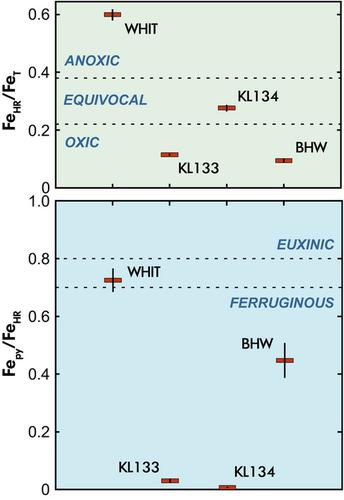当前位置:
X-MOL 学术
›
Geostand. Geoanal. Res.
›
论文详情
Our official English website, www.x-mol.net, welcomes your
feedback! (Note: you will need to create a separate account there.)
Development of Iron Speciation Reference Materials for Palaeoredox Analysis
Geostandards and Geoanalytical Research ( IF 2.7 ) Pub Date : 2020-05-26 , DOI: 10.1111/ggr.12342 Lewis J. Alcott 1 , Alexander J. Krause 1 , Emma U. Hammarlund 2 , Christian J. Bjerrum 3 , Florian Scholz 4 , Yijun Xiong 1 , Andrew J. Hobson 1 , Lesley Neve 1 , Benjamin J. W. Mills 1 , Christian März 1 , Bernhard Schnetger 5 , Andrey Bekker 6 , Simon W. Poulton 1
Geostandards and Geoanalytical Research ( IF 2.7 ) Pub Date : 2020-05-26 , DOI: 10.1111/ggr.12342 Lewis J. Alcott 1 , Alexander J. Krause 1 , Emma U. Hammarlund 2 , Christian J. Bjerrum 3 , Florian Scholz 4 , Yijun Xiong 1 , Andrew J. Hobson 1 , Lesley Neve 1 , Benjamin J. W. Mills 1 , Christian März 1 , Bernhard Schnetger 5 , Andrey Bekker 6 , Simon W. Poulton 1
Affiliation

|
The development and application of geochemical techniques to identify redox conditions in modern and ancient aquatic environments has intensified over recent years. Iron (Fe) speciation has emerged as one of the most widely used procedures to distinguish different redox regimes in both the water column and sediments, and is the main technique used to identify oxic, ferruginous (anoxic, Fe(II) containing) and euxinic (anoxic, sulfidic) water column conditions. However, an international sediment reference material has never been developed. This has led to concern over the consistency of results published by the many laboratories that now utilise the technique. Here, we report an interlaboratory comparison of four Fe speciation reference materials for palaeoredox analysis, which span a range of compositions and reflect deposition under different redox conditions. We provide an update of extraction techniques used in Fe speciation and assess the effects of both test portion mass, and the use of different analytical procedures, on the quantification of different Fe fractions in sedimentary rocks. While atomic absorption spectroscopy and inductively coupled plasma‐optical emission spectrometry produced comparable Fe measurements for all extraction stages, the use of ferrozine consistently underestimated Fe in the extraction step targeting mixed ferrous–ferric minerals such as magnetite. We therefore suggest that the use of ferrozine is discontinued for this Fe pool. Finally, we report the combined data of four independent Fe speciation laboratories to characterise the Fe speciation composition of the reference materials. These reference materials are available to the community to provide an essential validation of in‐house Fe speciation measurements.
中文翻译:

用于古氧化还原分析的铁形态参考物质的开发
近年来,为确定现代和古代水生环境中的氧化还原条件的地球化学技术的开发和应用已得到加强。铁(Fe)形态已成为区分水柱和沉积物中不同氧化还原形式的最广泛使用的方法之一,并且是用于鉴定有氧,含铁(缺氧,含Fe(II))和富氧的主要技术。 (缺氧,硫化)水柱条件。然而,从未开发出国际沉积物参考材料。这引起了人们对现在利用该技术的许多实验室发表的结果的一致性的担忧。在这里,我们报告了四种用于旧氧化还原分析的铁形态参考物质的实验室间比较,它涵盖了一系列成分,并反映了不同氧化还原条件下的沉积。我们提供了一种用于铁矿形态的提取技术的更新,并评估了两个测试部分的质量以及使用不同的分析程序对沉积岩中不同铁含量的定量的影响。尽管原子吸收光谱法和电感耦合等离子体发射光谱法在所有提取阶段都能获得可比的铁测量结果,但在针对混合铁-铁矿物质(例如磁铁矿)的提取步骤中,铁锰的使用始终低估了铁。因此,我们建议停止对该铁矿池使用铁锌。最后,我们报告了四个独立的铁形态实验室的综合数据,以表征标准物质的铁形态组成。这些参考材料可供社区使用,以提供对室内铁形态测量的基本验证。
更新日期:2020-05-26
中文翻译:

用于古氧化还原分析的铁形态参考物质的开发
近年来,为确定现代和古代水生环境中的氧化还原条件的地球化学技术的开发和应用已得到加强。铁(Fe)形态已成为区分水柱和沉积物中不同氧化还原形式的最广泛使用的方法之一,并且是用于鉴定有氧,含铁(缺氧,含Fe(II))和富氧的主要技术。 (缺氧,硫化)水柱条件。然而,从未开发出国际沉积物参考材料。这引起了人们对现在利用该技术的许多实验室发表的结果的一致性的担忧。在这里,我们报告了四种用于旧氧化还原分析的铁形态参考物质的实验室间比较,它涵盖了一系列成分,并反映了不同氧化还原条件下的沉积。我们提供了一种用于铁矿形态的提取技术的更新,并评估了两个测试部分的质量以及使用不同的分析程序对沉积岩中不同铁含量的定量的影响。尽管原子吸收光谱法和电感耦合等离子体发射光谱法在所有提取阶段都能获得可比的铁测量结果,但在针对混合铁-铁矿物质(例如磁铁矿)的提取步骤中,铁锰的使用始终低估了铁。因此,我们建议停止对该铁矿池使用铁锌。最后,我们报告了四个独立的铁形态实验室的综合数据,以表征标准物质的铁形态组成。这些参考材料可供社区使用,以提供对室内铁形态测量的基本验证。









































 京公网安备 11010802027423号
京公网安备 11010802027423号